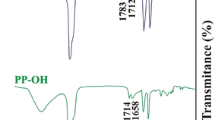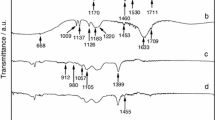Abstract
To improve the dispersibility of carbon nanotubes (CNTs), poly(vinylferrocene-co-styrene) (poly (Vf-co-St)), was grafted onto the surface of CNTs by a ligand-exchange reaction. Poly(Vf-co-St) was obtained by a radical copolymerization reaction using styrene and vinylferrocene as the monomers. The vinylferrocene was synthesized from ferrocene via a Friedel-Crafts acylation. The molecular weight, molecular weight distribution, and amount of Vf in the poly(Vf-co-St) were 1.32 × 104, 1.69 and 17.6% respectively. The degree of grafting of the copolymer onto the CNTs surface was calculated from thermogravimetric analysis and varied from 27.1% to 79.7%. The addition of the poly(Vf-co-St) greatly promoted the dispersibility of the modified CNTs in anhydrous alcohol. The electrical conductivity of composites prepared from the polymer-grafted CNTs and copolymer (acrylonitrile, 1,3-butadiene and styrene, ABS) strongly depended on the degree of grafting. These results show that the amount of polymer grafted onto the surface of CNTs can be controlled and that the electrical properties of composites prepared with these grafted polymers can be tuned.
Similar content being viewed by others
References
Nadler M, Werner J, Mahrholz T, Riedel U, Hufenbach W. Effect of CNT surface functionalisation on the mechanical properties of multi-walled carbon nanotube/epoxy-composites. Composites. Part A, Applied Science and Manufacturing, 2009, 40(6–7): 932–937
Paredes J I, Burghard M. Dispersions of individual single-walled carbon nanotubes of high length. Langmuir, 2004, 20(12): 5149–5152
Islam M F, Rojas E, Bergey D M, Johnson A T, Yodh A G. High weight fraction surfactant solubilization of single-wall carbon nanotubes in water. Nano Letters, 2003, 3(2): 269–273
Kim J Y, Han S I, Hong S. Effect of modified carbon nanotube on the properties of aromatic polyester nanocomposites. Polymer, 2008, 49(15): 3335–3345
Zhang W D, Shen L, Phang I Y, Liu T X. Carbon nanotubes reinforced nylon-6 composite prepared by simple melt-compounding. Macromolecules, 2004, 37(2): 256–259
McNally T, Pötschke P, Halley P, Murphy M, Martin D, Bell S E J, Brennan G P, Bein D, Lemoine P, Quinn J P. Polyethylene multiwalled carbon nanotube composites. Polymer, 2005, 46(19): 8222–8232
Syed M A, Syed T H, Saqib A, Nisar A, Nisar A, Saghir A, Zulfiqar A. Modification of carbon nanotubes by CuO-doped NiO nanocomposite for use as an anode material for lithium-ion batteries. Journal of Solid State Chemistry, 2013, 202: 43–50
Wong M, Paramsothy M, Xu X J, Ren Y, Li S, Liao K. Physical interactions at carbon nanotube-polymer interface. Polymer, 2003, 44(25): 7757–7764
Cui H F, Ye J S, Zhang W D, Sheu F S. Modification of carbon nanotubes with redox hydrogel: improvement of amperometric sensing sensitivity for redox enzymes. Biosensors & Bioelectronics, 2009, 24(6): 1723–1729
Lee S W, Oda T, Shin P K, Lee B J. Chemical modification of carbon nanotube for improvement of field emission property. Microelectronic Engineering, 2009, 86(10): 2110–2113
Tsubokawa N, Abe N, Wei G, Chen J, Saitoh S, Fujiki K. Grafting of polymers onto a carbon-fiber surface by ligand-exchange reaction of poly(vinyl ferrocene-co-vinyl monomer) with polycondensed aromatic rings of the surface. Journal of Polymer Science. Part A, Polymer Chemistry, 2002, 40(11): 1868–1875
Tsubokawa N, Abe N, Seida Y, Fujiki K. Grafting of polymers onto carbon fiber surface by ligand exchange reaction of poly(vinylferrocene-co-methyl methacrylate) with polycondensed aromatic ring of the surface. Chemistry Letters, 2000, 29(8): 900–901
Author information
Authors and Affiliations
Corresponding author
Rights and permissions
About this article
Cite this article
Shi, R., Wang, H., Tang, P. et al. Synthesis of vinylferrocene and the ligand-exchange reaction between its copolymer and carbon nanotubes. Front. Chem. Sci. Eng. 8, 171–178 (2014). https://doi.org/10.1007/s11705-014-1428-8
Received:
Accepted:
Published:
Issue Date:
DOI: https://doi.org/10.1007/s11705-014-1428-8




